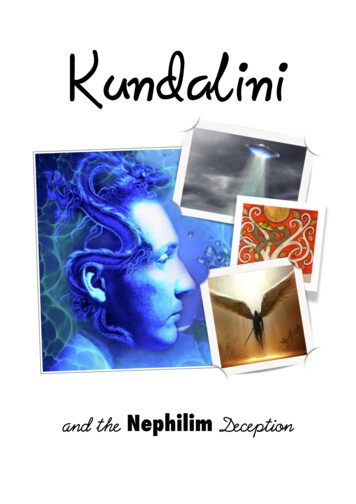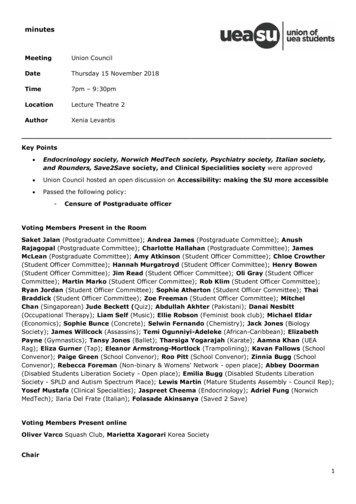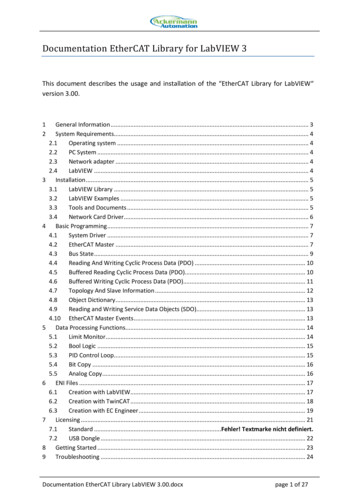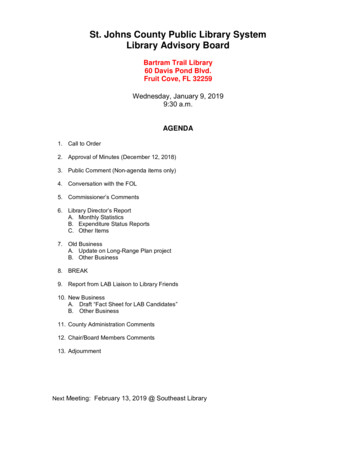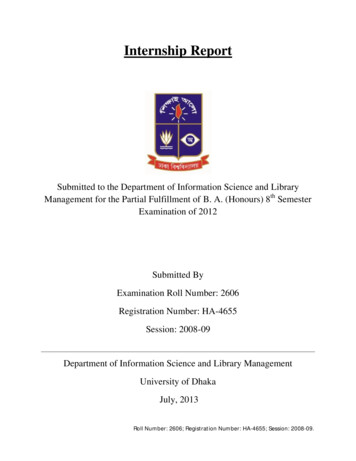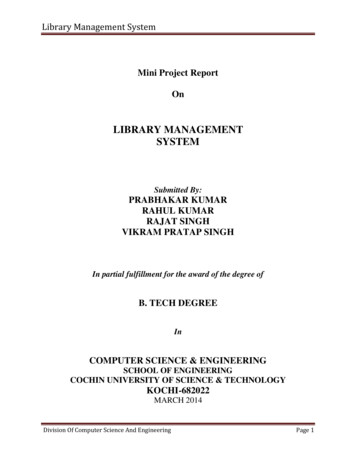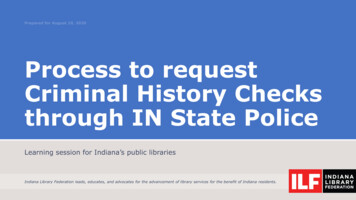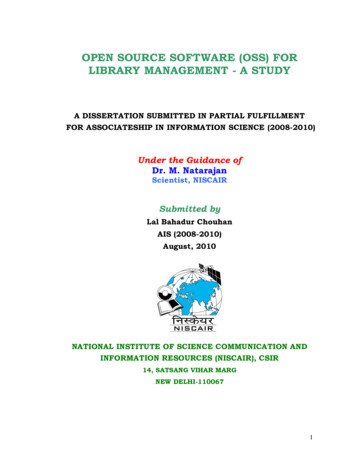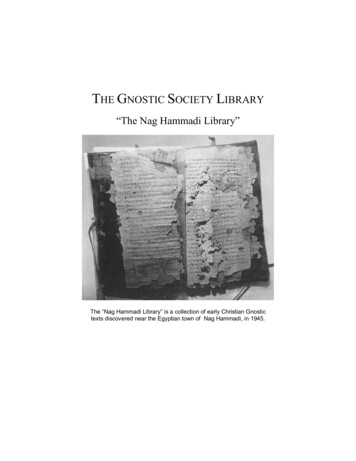
Transcription
THE GNOSTIC SOCIETY LIBRARY“The Nag Hammadi Library”The “Nag Hammadi Library” is a collection of early Christian Gnostictexts discovered near the Egyptian town of Nag Hammadi, in 1945.
Nag Hammadi libraryThe Nag Hammadi library (popularly known as The Gnostic Gospels) is a collectionof early Christian Gnostic texts discovered near the town of Nag Hammâdi in 1945. Thatyear, twelve leather-bound papyrus codices buried in a sealed jar were found by a localpeasant named Mohammed Ali. The writings in these codices comprised fifty-two mostlyGnostic tractates (treatises), but they also include three works belonging to the CorpusHermeticum and a partial translation / alteration of Plato's “Republic”. In his"Introduction" to “The Nag Hammadi Library” in English, James Robinson suggests thatthese codices may have belonged to a nearby Pachomian monastery, and were buriedafter Bishop Athanasius condemned the uncritical use of non-canonical books in hisFestal Letter of 367 AD.The contents of the codices were written in Coptic, though the works were probably alltranslations from Greek. The best-known of these works is probably the “Gospel ofThomas”, of which the “Nag Hammadi Codices” contain the only complete text. Afterthe discovery it was recognized that fragments of these sayings of Jesus appeared inmanuscripts discovered at Oxyrhynchus in 1898, and matching quotations wererecognized in other early Christian sources. Subsequently, a 1st or 2nd century date ofcomposition circa 80 AD for the lost Greek originals of the Gospel of Thomas has beenproposed, though this is disputed by many if not the majority of biblical matterresearchers. The once buried manuscripts themselves date from the 3rd and 4th centuries.The Nag Hammadi codices are housed in the Coptic Museum in Cairo, Egypt. To readabout their significance to modern scholarship into early Christianity, refer to works onGnosticism.Discovery at Nag HammadiThe story of the discovery of the Nag Hammadi library in 1945 has been described as'exciting as the contents of the find itself' (Markschies, Gnosis: An Introduction, 48). InDecember of that year, two Egyptian brothers found several papyri in a largeearthernware vessel while digging for fertilizer around limestone caves near present-dayHabra Dom in Upper Egypt. The find was not initially reported by either of the brothers,who sought to make money from the manuscripts by selling them individually atintervals. It is also reported that the brothers' mother burned several of the manuscripts,worried, apparently, that the papers might have 'dangerous effects' (Markschies, Gnosis,48). As a result, what came to be known as the Nag Hammadi library (owing to theproximity of the find to Nag Hammadi, the nearest major settlement) appeared onlygradually, and its significance went unacknowledged until some time after its initialuncovering.2
In 1946, the brothers became involved in a feud, and left the manuscripts with a Copticpriest, whose brother-in-law in October that year sold a codex to the Coptic Museum inOld Cairo (this tract is today numbered Codex III in the collection). The residentCoptologist and religious historian Jean Dorese, realizing the significance of the artifact,published the first reference to it in 1948. Over the years, most of the tracts were passedby the priest to a Cypriot antiques dealer in Cairo, thereafter being retained by theDepartment of Antiquities, for fear that they would be sold out of the country. After therevolution in 1956, these texts were handed to the Coptic Museum in Cairo, and declarednational property.Meanwhile, a single codex had been sold in Cairo to a Belgian antique dealer. After anattempt was made to sell the codex in both New York and Paris, it was acquired by theCarl Gustav Jung Institute in Zurich in 1951, through the mediation of Gilles Quispel.There it was intended as a birthday present to the famous psychologist; for this reason,this codex is typically known as the “Jung Codex”, being Codex I in the collection.Jung's death in 1961 caused a quarrel over the ownership of the Jung Codex, with theresult that the pages were not given to the Coptic Museum in Cairo until 1975, after afirst edition of the text had been published. Thus the papyri were finally brought togetherin Cairo: of the 1945 find, eleven complete books and fragments of two others,'amounting to well over 1000 written pages' (Markschies, Gnosis: An Introduction, 49)are preserved there.TranslationThe first edition of a text found at Nag Hammadi was from the Jung Codex, a partialtranslation of which appeared in Cairo in 1956, and a single extensive facsimile editionwas planned. Due to the difficult political circumstances in Egypt, individual tractsfollowed from the Cairo and Zurich collections only slowly.This state of affairs changed only in 1966, with the holding of the Messina Congress inItaly. At this conference, intended to allow scholars to arrive at a group consensusconcerning the definition of gnosticism, James M. Robinson, an expert on religion,assembled a group of editors and translators whose express task was to publish abilingual edition of the Nag Hammadi codices in English, in collaboration with theInstitute for Antiquity and Christianity at the Claremont Graduate University inClaremont, California. Robinson had been elected secretary of the InternationalCommittee for the Nag Hammadi Codices, which had been formed in 1970 by UNESCOand the Egyptian Ministry of Culture; it was in this capacity that he oversaw the project.In the meantime, a facsimile edition in twelve volumes did appear between 1972 and1977, with subsequent additions in 1979 and 1984 from publisher E.J. Brill in Leiden,called “The Facsimile Edition of the Nag Hammadi Codices”, making the whole findavailable for all interested parties to study in some form.At the same time, in the former German Democratic Republic a group of scholars including Alexander Bohlig, Martin Krause and New Testament scholars Gesine3
Schenke, Hans-Martin Schenke and Hans-Gebhard Bethge - were preparing the firstGerman translation of the find. The last three scholars prepared a complete scholarlytranslation under the auspices of the Berlin Humboldt University, which was published in2001.The James M. Robinson translation was first published in 1977, with the name “The NagHammadi Library in English”, in collaboration between E.J. Brill and Harper & Row.The single-volume publication, according to Robinson, 'marked the end of one stage ofNag Hammadi scholarship and the beginning of another' (from the Preface to the thirdrevised edition). Paperback editions followed in 1981 and 1984, from E.J. Brill andHarper respectively. A third, completely revised edition was published in 1988. Thismarks the final stage in the gradual dispersal of gnostic texts into the wider public arena the full complement of codices was finally available in unadulterated form to peoplearound the world, in a variety of languages.A further English edition was published in 1987, by Yale scholar Bentley Layton, called“The Gnostic Scriptures: A New Translation with Annotations” (Garden City: Doubleday& Co., 1987). The volume unified new translations from the Nag Hammadi Library withextracts from the heresiological writers, and other gnostic material. It remains, along with“The Nag Hammadi Library in English” one of the more accessible volumes translatingthe Nag Hammadi find, with extensive historical introductions to individual gnosticgroups, notes on translation, annotations to the text and the organisation of tracts intoclearly defined movements.4
Complete list of Codices found in the Nag HammadiSeveral of the major texts in the Nag Hammadi collection have more than one Englishtranslation; where more than one translation is available, we have listed the translators'names in parenthesis below the name of the text. Texts marked with the {*} had morethan one version extant within the Nag Hammadi Codices; often these several versionswere used conjointly by the translators to provide the single translation presented here.INDEX (while loaded into Word): press-&-hold-down the “Control Key”, thenclick-on the desired chapter. This will cause a jump-to the selected page. The Acts of Peter and the Twelve Apostles. 7Allogenes . 12The Apocalypse of Adam. 20The (First) Apocalypse of James . 26The (Second) Apocalypse of James . 31The Apocalypse of Paul . 37The Apocalypse of Peter . 39The Apocryphon of James. 44The Apocryphon of James. 50The Apocryphon of James. 56The Apocryphon of John (The Secret Book of John - The Secret Revelation of John). 62The Apocryphon of John (The Secret Book of John - The Secret Revelation of John). 77The Apocryphon of John (The Secret Book of John -- The Secret Revelation of Jon) . 92Short Version Berlin Codex (BG 8502,2) & Nag Hammadi Codex III,1. 92The Apocryphon of John (The Secret Book of John -- The Secret Revelation of John) . 109Long Version Nag Hammadi Codex II,1 & Nag Hammadi Codex IV,1 . 109Asclepius 21-29. 163Authoritative Teaching . 169The Book of Thomas the Contender . 174The Concept of Our Great Power . 180The Dialogue of the Savior . 185The Discourse on the Eighth and Ninth . 192Eugnostos the Blessed. 197The Exegesis on the Soul . 202The Gospel of the Egyptians . 208The Gospel of Philip . 217The Gospel of Thomas. 233The Gospel of Thomas. 246The Gospel of Thomas. 259The Gospel of Thomas. 271The Gospel of Truth. 286The Gospel of Truth. 295The Gospel of Truth. 304The Hypostasis of the Archons (The Reality of the Rulers). 313Hypsiphrone . 319The Interpretation of Knowledge. 3205
The Letter of Peter to Philip . 326Marsanes . 329Melchizedek . 337On the Anointing. 343On the Baptism A. 344On the Baptism B. 345On the Eucharist (A). 346On the Eucharist (B). 347On the Origin of the World ("The Untitled Text"). 348The Paraphrase Of Shem. 362Plato, Republic 588A-589B. 378The Prayer of the Apostle Paul. 380The Prayer of Thanksgiving . 381The Second Treatise of the Great Seth. 382The Sentences of Sextus. 389The Sophia of Jesus Christ . 396The Teachings of Silvanus . 403The Testimony of Truth . 415The Thought of Norea. 424The Three Steles of Seth . 425The Thunder, Perfect Mind . 429The Treatise on the Resurrection . 435Trimorphic Protennoia . 438The Tripartite Tractate . 446A Valentinian Exposition . 479Zostrianos. 4836
THE GNOSTIC SOCIETY LIBRARYThe Nag Hammadi LibraryThe Acts of Peter and the Twelve ApostlesTranslated by Douglas M. Parrott and R. McL.Wilson[.] which [.] purpose [. after .] us [.] apostles [.]. We sailed [.] of the body. Otherswere not anxious in their hearts. And in our hearts, we were united. We agreed to fulfillthe ministry to which the Lord appointed us. And we made a covenant with each other.We went down to the sea at an opportune moment, which came to us from the Lord. Wefound a ship moored at the shore ready to embark, and we spoke with the sailors of theship about our coming aboard with them. They showed great kindliness toward us as wasordained by the Lord. And after we had embarked, we sailed a day and a night. After that,a wind came up behind the ship and brought us to a small city in the midst of the sea.And I, Peter, inquired about the name of this city from residents who were standing onthe dock. A man among them answered, saying, "The name of this city is Habitation, thatis, Foundation [.] endurance." And the leader among them holding the palm branch atthe edge of the dock. And after we had gone ashore with the baggage, I went into the city,to seek advice about lodging.A man came out wearing a cloth bound around his waist, and a gold belt girded it. Also anapkin was tied over his chest, extending over his shoulders and covering his head andhis hands.I was staring at the man, because he was beautiful in his form and stature. There werefour parts of his body that I saw: the soles of his feet and a part of his chest and the palmsof his hands and his visage. These things I was able to see. A book cover like (those of)my books was in his left hand. A staff of styrax wood was in his right hand. His voicewas resounding as he slowly spoke, crying out in the city, "Pearlsl Pearlsl"I, indeed, thought he was a man of that city. I said to him, "My brother and my friend!"He answered me, then, saying, "Rightly did you say, 'My brother and my friend.' What isit you seek from me?" I said to him, "I ask you about lodging for me and the brothersalso, because we are strangers here." He said to me, "For this reason have I myself justsaid, 'My brother and my friend,' because I also am a fellow stranger like you."And having said these things, he cried out, "Pearls! Pearls!" The rich men of that cityheard his voice. They came out of their hidden storerooms. And some were looking out7
from the storerooms of their houses. Others looked out from their upper windows. Andthey did not see (that they could gain) anything from him, because there was no pouch onhis back nor bundle inside his cloth and napkin. And because of their disdain they did noteven acknowledge him. He, for his part, did not reveal himself to them. They returned totheir storerooms, saying, "This man is mocking us."And the poor of that city heard his voice, and they came to the man who sells this pearl.They said, "Please take the trouble to show us the pearl so that we may, then, see it withour (own) eyes. For we are the poor. And we do not have this [.] price to pay for it. Butshow us that we might say to our friends that we saw a pearl with our (own) eyes." Heanswered, saying to them, "If it is possible, come to my city, so that I may not only showit before your (very) eyes, but give it to you for nothing."And indeed they, the poor of that city, heard and said, "Since we are beggars, we surelyknow that a man does not give a pearl to a beggar, but (it is) bread and money that isusually received. Now then, the kindness which we want to receive from you (is) that youshow us the pearl before our eyes. And we will say to our friends proudly that we saw apearl with our (own) eyes" - because it is not found among the poor, especially suchbeggars (as these). He answered (and) said to them, "If it is possible, you yourselvescome to my city, so that I may not only show you it, but give it to you for nothing." Thepoor and the beggars rejoiced because of the man who gives for nothing.The men asked Peter about the hardships. Peter answered and told those things that hehad heard about the hardships of the way. Because they are interpreters of the hardshipsin their ministry.He said to the man who sells this pearl, "I want to know your name and the hardships ofthe way to your city because we are strangers and servants of God. It is necessary for usto spread the word of God in every city harmoniously." He answered and said, "If youseek my name, Lithargoel is my name, the interpretation of which is, the light, gazellelike stone."And also (concerning) the road to the city, which you asked me about, I will tell youabout it. No man is able to go on that road, except one who has forsaken everything thathe has and has fasted daily from stage to stage. For many are the robbers and wild beastson that road. The one who carries bread with him on the road, the black dogs kill becauseof the bread. The one who carries a costly garment of the world with him, the robbers killbecause of the garment. The one who carries water with him, the wolves kill because ofthe water, since they were thirsty for it. The one who is anxious about meat and greenvegetables, the lions eat because of the meat. If he evades the lions, the bulls devour himbecause of the green vegetables."When he had said these things to me, I sighed within myself, saying, "Great hardships areon the road! If only Jesus would give us power to walk it!" He looked at me since myface was sad, and I sighed. He said to me, "Why do you sigh, if you, indeed, know this8
name "Jesus" and believe him? He is a great power for giving strength. For I too believein the Father who sent him."I replied, asking him, "What is the name of the place to which you go, your city?" Hesaid to me, "This is the name of my city, 'Nine Gates.' Let us praise God as we aremindful that the tenth is the head." After this I went away from him in peace.As I was about to go and call my friends, I saw waves and large high walls surroundingthe bounds of the city. I marveled at the great things I saw. I saw an old man sitting and Iasked him if the name of the city was really Habitation. He [.], "Habitation [.]." He saidto me, "You speak truly, for we inhabit here because we endure."I responded, saying, "Justly [.] have men named it [.], because (by) everyone whoendures his trials, cities are inhabited, and a precious kingdom comes from them, becausethey endure in the midst of the apostasies and the difficulties of the storms. So that in thisway, the city of everyone who endures the burden of his yoke of faith will be inhabited,and he will be included in the kingdom of heaven."I hurried and went and called my friends so that we might go to the city that he,Lithargoel, appointed for us. In a bond of faith we forsook everything as he had said (todo). We evaded the robbers, because they did not find their garments with us. We evadedthe wolves, because they did not find the water with us for which they thirsted. Weevaded the lions, because they did not find the desire for meat with us. We evaded thebulls [.] they did not find green vegetables.A great joy came upon us and a peaceful carefreeness like that of our Lord. We restedourselves in front of the gate, and we talked with each other about that which is not adistraction of this world. Rather we continued in contemplation of the faith.As we discussed the robbers on the road, whom we evaded, behold Lithargoel, havingchanged, came out to us. He had the appearance of a physician, since an unguent box wasunder his arm, and a young disciple was following him carrying a pouch full of medicine.We did not recognize him.Peter responded and said to him, "We want you to do us a favor, because we arestrangers, and take us to the house of Lithargoel before evening comes." He said, "Inuprightness of heart I will show it to you. But I am amazed at how you knew this goodman. For he does not reveal himself to every man, because he himself is the son of a greatking. Rest yourselves a little so that I may go and heal this man and come (back)." Hehurried and came (back) quickly.He said to Peter, "Peter!" And Peter was frightened, for how did he know that his namewas Peter? Peter responded to the Savior, "How do you know me, for you called myname?" Lithargoel answered, "I want to ask you who gave the name Peter to you?" Hesaid to him, "It was Jesus Christ, the son of the living God. He gave this name to me." Heanswered and said, "It is I! Recognize me, Peter." He loosened the garment, which9
clothed him - the one into which he had changed himself because of us - revealing to usin truth that it was he.We prostrated ourselves on the ground and worshipped him. We comprised elevendisciples. He stretched forth his hand and caused us to stand. We spoke with him humbly.Our heads were bowed down in unworthiness as we said, "What you wish we will do.But give us power to do what you wish at all times."He gave them the unguent box and the pouch that was in the hand of the young disciple.He commanded them like this, saying, "Go into the city from which you came, which iscalled Habitation. Continue in endurance as you teach all those who have believed in myname, because I have endured in hardships of the faith. I will give you your reward. Tothe poor of that city give what they need in order to live until I give them what is better,which I told you that I will give you for nothing."Peter answered and said to him, "Lord, you have taught us to forsake the world andeverything in it. We have renounced them for your sake. What we are concerned about(now) is the food for a single day. Where will we be able to find the needs that you ask usto provide for the poor?"The Lord answered and said, "O Peter, it was necessary that you understand the parablethat I told you! Do you not understand that my name, which you teach, surpasses allriches, and the wisdom of God surpasses gold, and silver and precious stone(s)?"He gave them the pouch of medicine and said, "Heal all the sick of the city who believein my name." Peter was afraid to reply to him for the second time. He signaled to the onewho was beside him, who was John: "You talk this time." John answered and said, "Lord,before you we are afraid to say many words. But it is you who asks us to practice thisskill. We have not been taught to be physicians. How then will we know how to healbodies as you have told us?"He answered them, "Rightly have you spoken, John, for I know that the physicians of thisworld heal what belongs to the world. The physicians of souls, however, heal the heart.Heal the bodies first, therefore, so that through the real powers of healing for their bodies,without medicine of the world, they may believe in you, that you have power to heal theillnesses of the heart also."The rich men of the city, however, those who did not see fit even to acknowledge me,but who reveled in their wealth and pride - with such as these, therefore, do not dine intheir houses nor be friends with them, lest their partiality influence you. For many in thechurches have shown partiality to the rich, because they also are sinful, and they giveoccasion for others to sin. But judge them with uprightness, so that your ministry may beglorified, and that my name also, may be glorified in the churches." The disciplesanswered and said, "Yes, truly this is what is fitting to do."10
They prostrated themselves on the ground and worshipped him. He caused them to standand departed from them in peace. Amen.The Acts of Peter and the Twelve ApostlesSelection made from James M. Robinson, ed., The Nag Hammadi Library, revised edition. HarperCollins, San Francisco, 1990.11
THE GNOSTIC SOCIETY LIBRARYThe Nag Hammadi LibraryAllogenesTranslated by John D.Turner and Orval S. Wintermute(5 lines missing). since they are perfect individuals and dwell all together, joined with the mind, theguardian which I provided, who taught you (sg.). And it is the power that exists withinyou that often extended itself as word from the Triple-Powered One, that One of all thosewho truly exist with the Immeasurable One, the eternal Light of the Knowledge thatappeared, the male virginal Youth, the first of the Aeons from a unique triple-poweredAeon, the Triple-Powered-One who truly exists, for when he was stilled, was extendedand when he was extended, he became complete and he received power from all of them.He knows himself and the perfect Invisible Spirit. And he came to be in an Aeon whoknows that she knows That One. And she became Kalyptos, who acted in those whomshe knows. He is a perfect, invisible, noetic Protophanes-Harmedon. And empoweringthe individuals, she is a Triple-Male. And being individually .(5 lines missing). individual on the one hand, they are together on the other hand, since she is anexistence of theirs, and she sees them all also truly. She contains the divine Autogenes.When she knew her Existence and when she stood, she brought This One (masc.), sincehe saw them all existing individually as he is. And when they become as he is, they shallsee the divine Triple-Male, the power that is higher than God. He is the Thought of allthese who exist together. If he ponders them, he ponders the great male [.] noeticProtophanes, the procession of these. When he sees it, he sees also those who truly existand the procession of those who are together. And when he has seen these, he has seenthe Kalyptos. And if he sees one of the hidden ones, he sees the Aeon of Barbelo. And asfor the unbegotten offspring of That One, if one sees how he lives .(4 lines missing). you have heard about the abundance of each one of them certainly.But concerning the invisible, spiritual Triple-Powered-One, hear! He exists as anInvisible One who is incomprehensible to them all. He contains them all within himself,for they all exist because of him. He is perfect, and he is greater than perfect, and he isblessed. He is always One and he exists in them all, being ineffable, unnameable, beingOne who exists through them all - he whom, should one discern him, one would notdesire anything that exists before him among those that possess existence, for he is thesource from which they were all emitted.
Hammadi Library in English”, in collaboration between E.J. Brill and Harper & Row. The single-volume publication, according to Robinson, 'marked the end of one stage of Nag Hammadi scholarship and the beginning of another' (from the Preface to the third revised edition). Paperbac
